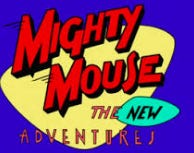History
Mighty Mouse, the beloved anthropomorphic superhero mouse, was born from the creative minds at the Terrytoons studio under 20th Century Fox's banner. Originally known as "Super Mouse," this iconic character debuted in the 1942 short film "The Mouse of Tomorrow." However, it was not until his eighth film, "The Wreck of the Hesperus" (1944), that the character's name was changed to Mighty Mouse. A total of eighty theatrical shorts showcased Mighty Mouse's adventures, with the final instalment being "Cat Alarm" in 1961.
After his changes, the theatrical cartoon became a popular Saturday morning show, Mighty Mouse Playhouse. Using the existing film library, the show aired from December 1955 through September 1967. The comics took on the ‘damsel in distress’ mantra, with our hero inevitably saving the day. However, as the times started to change, the might of the mouse began to wain.
From 1979–1980, the television cartoons were called The New Adventures of Mighty Mouse, which introduced new characters, a vampire duck named Quacula (not to be confused with Count Duckula) and Oil Can Harry, a giant henchman. The show premiered in 1979 and lasted two seasons.
In 1987 and 1988, and new series was created entitled Mighty Mouse: The New Adventures for the CBS Saturday morning children's lineup. In this series, Mighty Mouse has a real identity.
Marvel Comics produced a 10-issue comic book series in 1990 and 1991. Since then, this is the first time anyone has been created using the Mighty Mouse character except for a 2001 television commercial showing Mighty Mouse dining calmly on cheese in a restaurant, totally unconcerned with a scene of chaos and terror unfolding in the street outside. The commercial was withdrawn after September 11, 2001
As early as 2004, Paramount Pictures and Nickelodeon Movies announced their intention to bring Mighty Mouse back to the big screen. However, to date, this has yet to happen and looks unlikely to do so.
Plotline
Mighty Mouse's storyline centres around his heroic efforts to protect his fellow mice from various adversaries. His early adventures often saw him battling menacing cats, with nods to classic superhero themes. His powers included flight, super-strength, invulnerability, and occasionally more extraordinary abilities like X-ray vision and time manipulation. Mighty Mouse's character took on symbolic and religious undertones, depicted as a saviour figure for all mouse-kind.
Characters
Mighty Mouse's adversaries primarily consisted of nondescript cats, symbolising danger to the mouse community. Some specific villains, such as the Bat-cats and the powerful cat Julius "Pinhead" Schlabotka, made memorable appearances. Non-feline foes included the human villain Bad Bill Bunion, his horse, and the intriguing Automatic Mouse Trap, a brontosaur-shaped robotic monster. The character also encountered unique scenarios where he resolved conflicts between cats and mice or saved a damsel in distress.
Merchandise
Mighty Mouse's popularity extended beyond the screen, leading to the creation of various merchandise. The character appeared in comic book series such as "Mighty Mouse" and "The Adventures of Mighty Mouse," from 1946 to 1968. Additionally, Mighty Mouse's theme song, "Mighty Mouse Theme (Here I Come to Save the Day)," composed by Marshall Barer, became a notable attribute associated with the character.
Fun Facts
For his first outing, he was named Super Mouse, later changing this to Mighty Mouse.
His catchphrase ‘Here I come to save the day!” is part of the theme tune accompanying his daring deeds.
He sang his catchphrase in a theatrical, operatic style.
The Mighty Mouse Theme by Todd Terry sampled the cartoon's theme, which became a dance music hit in the 1980s.
Thank you for reading, and, as ever, this post is free and public, so if you have any friends or enemies you think might like it, please feel free to share.






That’s so cool. We didn’t have anything quite as ace. A small ride on a horse that went forward and back. I’ve lived a sheltered life 😁
It had some great music, not sure why it took the operatic route? Thanks so much for reading.